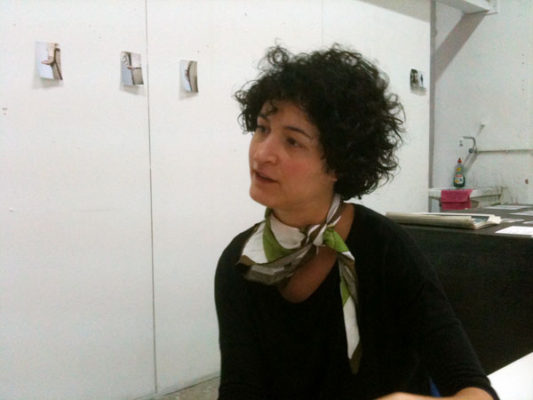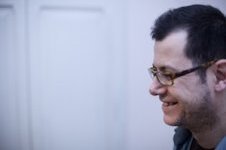Search
To search for an exact match, type the word or phrase you want in quotation marks.
A*DESK has been offering since 2002 contents about criticism and contemporary art. A*DESK has become consolidated thanks to all those who have believed in the project, all those who have followed us, debating, participating and collaborating. Many people have collaborated with A*DESK, and continue to do so. Their efforts, knowledge and belief in the project are what make it grow internationally. At A*DESK we have also generated work for over one hundred professionals in culture, from small collaborations with reviews and classes, to more prolonged and intense collaborations.
At A*DESK we believe in the need for free and universal access to culture and knowledge. We want to carry on being independent, remaining open to more ideas and opinions. If you believe in A*DESK, we need your backing to be able to continue. You can now participate in the project by supporting it. You can choose how much you want to contribute to the project.
You can decide how much you want to bring to the project.

The exhibition rooms of a museum, in which, over the years, a security guard has compiled information about what happens there. Mireia C. Saladrigues invited a security guard to write about her memories of this time. The gaze and opinions of the one who is supposedly invisible serve as a point of departure in the exhibition to analyse institutional behaviour, as well as that of the public. Saladrigues has published a book with the memories of the invigilator, and recently it was the first proposal in a cycle of exhibitions of Espai 13, “The End is Where We Start From”, curated by Karin Campbell.
Oriol Fontdevila: Your exhibition project “El seu museu” (Her museum) focuses on the role of a security guard, Montserrat, who has worked for years in the exhibition rooms of a museum. The name of the museum, which the memories talk about in the publication, that we can acquire on entering the exhibition space, remains hidden at all times. What was reason that made you invite a security guard to write her memories?
Mireia C. Saladrigues: I have known Montserrat for quite a few years. It happened by chance, she had seen me around the bakery that my parents own, and one day, finding me in the museum where she worked, she recognised me and asked, “hey, are you not what’s her name?” All things considered it could have been just an anecdote, but as I visited the exhibitions in the museum, a closer relationship began to evolve.
My attention was drawn to the way in which she subjectified the norms of the museum space, and although it arose from a strong involvement in her work, her identification with it ended up being almost excessive, leading her at times to consider the museum as if it was her own. Something similar occurred with her relationship with the uniform: if initially its purpose was to tone down the subjectivity of the person acting as security guard, in her case this was inverted and she used the uniform to accentuate her femininity, by having the trousers taken in, substituting the shoes for high heels, etc.
The invisibility that the stories she told me usually have, her capacity for observation and at the same time the confidence with which she confronted her relation with the public, led me to think it might be interesting to invite her to write her memories of this experience, something we have been working on since the beginning of 2010. As for as maintaining the anonymity of the museum where she worked, it has to do with a confidentiality clause that she had to comply with, as well as the fact that we didn’t want the reader’s attention to be drawn to any museum in particular. We wanted to deal with “the museum”, as when all is said and done Montserrat’s experiences are applicable to any other institution.
OF: Can you explain a bit about how the negotiations with her went? Is Montserrat aware that by exhibiting her case you are articulating a critical gaze towards the very security force to which she belongs?
MC: We haven’t come to verbalise it in quite this way; I think that her conflict is that she doesn’t feel like a disciplinary person and if she didn’t wear a uniform she wouldn’t act the way she does. But I don’t think that based on this project she will question whether museums should function one way or another. In fact the conversations that we have had during this time have been the point of departure for “Radicalment emancipat(s)” (Radically emancipated) (Barcelona, 2011), that explores the theft of bits of art works by the public. However, from her point of view these are totally reprehensible attitudes, without stopping to think about the relation that we have with the art objects or the desire that these can stimulate in the viewer. With regard to “El seu museu”, we have considered it as a sort of joint self-help project. On her part she recently left her job as a security guard and is in the process of establishing herself as a therapist, she equally sees the publication of the book as a bridge towards dedicating herself to writing, something that she also wants to develop.
OF: What do you think a museum should be today?
MS: I’m still not really sure. However I believe that there should be more room for dialogue and interaction with the public.
I find it funny that you are interviewing me, because suddenly it’s like being on the other side. Precisely because it is a format that I often use to elaborate my own projects, particularly the ones where I have dealt with aspects regarding the nature of the art sector. This is the case in “Projecte E/F” (Barcelona, 2007-2008), that reflects upon aspects relating to the condition of the artist. On that occasion I carried out around thirty interviews with different people, considering the topic, that to have a successful career it was necessary to go abroad.
Oriol Fontdevila: And what do you think?
MS: At the moment I’m clear that I want to be consequent with my projects. And I will go where they take me. My aim is not to get to know certain curators or to exhibit in specific art centres. At the time that I did “Projecte E/F ”, I had just returned after my first residency abroad, in Helsinki, and carrying out the project made me realise that I didn’t want to feel disconnected form the art world here. On the contrary, it seemed vital to know it well, to follow what was going on.
OF: In fact “Projecte E/F” already questions how the art circuit that you currently operate within functions.
MS: Exactly, it was one of the first projects that I did with this intention. On the other hand I also carried out dislocated projects in the street, such as the “Projecte Taulell” (Figueres – Terrassa, 2004-2005), which generated spaces for dialogue with the participants. In these cases, however, I was concerned with finding ways of evaluating what I was bringing to the public with the project. I was tired of reading books about relational aesthetics or contextual art, where what they did was deal with artists projects based on their interaction with the public, but in no case dealt with; the reception that these pieces had, the reaction of the people with the instigators of the project or the communities affected by it, etc, etc. I believe that a discourse was being generated where there seemed to be a fairly strong political implication on the part of some of the artists but that the social effects of these projects or how they should be evaluated were rarely discussed. Somehow or other it didn’t seemed very responsible.
OF: Projects like this could be seen as an evaluation in themselves with regard to certain aspects of the art world. In what sense do you think your projects are useful, according to which parameters do they aim to be effective? Do you think they could serve to improve the institutions with which you interact?
MS: I think that what I’m doing has a lot to do with a form of research that above all is personal. In the case of projects like the “El poder de la convocatòria” (The Power of the Open Call) or also “0912 10″(Barcelona, 2010), as well as like now with “El seu museu”, there is equally a desire to stimulate an awareness of the role the public plays, but in no case is there a direct and clear objective to satisfy or provide an answer for any institutions in particular. I believe that this is a delicate area and one I’m particularly wary of regarding how they interpret my projects. In fact, rather than seeing them as useful, I think they end up being quite compromising given their component of institutional critique. As far as the Fundació Joan Miró is concerned I think that Montserrat´s role, and the visualization of what an agent dedicated to controlling the public does, has caused them considerable discomfort. In fact, visitors to the Foundation are granted considerable leeway in comparison with many other cultural institutions. There aren’t any security guards in the exhibition rooms here, so it came as a surprise for them to leave one, acting in accordance with a guard’s specified criteria, in the Espai 13. In any event I’ve been surprised by the coolness of the reaction to this agent, who is in the space interacting with the public, gathering data, writing a diary about the experience of her shift, and it is true, this could also be significant information for the organisation of the space itself.
OF: And finally, the role of the artist, what do you think it should be in relation to society today?
MS: I’m very conscious that I have to generate critical thought, but at the same time I believe that in some way this is imposed upon us by the structure within which we move. Why on earth is it presupposed that I have a public function? Because I’m provided with some money to produce projects that are public? Or is it because there is still a hangover from the era of Velázquez or Goya, when it was understood that the function of these artists was to paint the king? In reality, even though I feel politically and socially responsible, I question the function of the artist practically every day.

Oriol Fontdevila thinks that the political and social dimensions of art practices and cultural phenomena are interesting; that the question of cultural innovation ought to be dealt in correlation with that of social progress: that cross-disciplinary working is an opportunity, not just to accumulate knowledge, but to generate surroundings from where to challenge them; and that art criticism and curating can contribute in this respect.
"A desk is a dangerous place from which to watch the world" (John Le Carré)